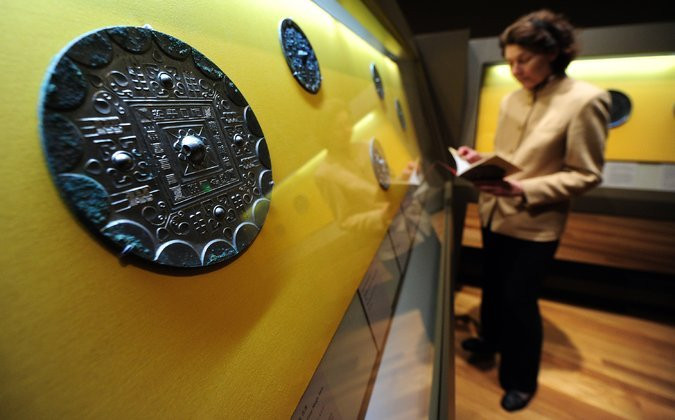The bronze mirror is still shiny after 1,900 years underground
The mirror of the Late Han Dynasty was preserved so intact that it could illuminate people after 1,900 years .
The 11.3-cm copper mirror was unearthed in April at Nakashima archaeological site in Fukuoka City, Japan, the International Business Times reported. According to the city authorities, this artifact was crafted in the Later Han Dynasty (year 25 - 220) and preserved intact to an incredible extent.

Bronze mirror 1900 years old.(Photo: AFP).
Such long-standing copper mirrors are often cracked or covered with copper, but the mirror is in such good condition that it still looms over the dim figure, according to the Asahi Shimbun. Researchers speculate that damp air around the site may have prevented the mirror from oxidizing.
The mirror is classified as a mirror with an arched edge connected by decorative motifs. The research team also found the inscription "Truong Nghi Tu Ton" means "descendants of eternal harmony" . In addition to the mirror, they found the last produced earthenware of the Yayoi period (from 300 BC to 300). The earthenware is located in the gallery of Fukuoka City Museum.
Scientists do not know the exact purpose of use, but Hidenori Okamura, a professor of archeology at Kyoto University, speculated that the mirror could serve anciently based on location.
- China unearthed the ancient bronze mirror manufacturing workshop
- Decode tricks of mummification from the Bronze Age
- The invention of a mirror with a much wider viewing angle than a conventional mirror
- Three blocks of bronze drum can not be more than 1,000 years old
- Strange mysteries around the mirror
- Detecting human bones in 2,000-year-old bronze drum
- Why do we find ourselves most beautiful in the mirror?
- The story strayed into the underground world of the 5-year-old boy, confusing the scientists
- The mirror of the
- China discovered a 2000-year-old green bronze sword as new
- Ancient arsenal discovered nearly 3,000 years old
- Looking at mirrors can predict the disease
 Discovered an ancient centipede fossil 99 million years old
Discovered an ancient centipede fossil 99 million years old Discovered bat-like dinosaurs in China
Discovered bat-like dinosaurs in China Discovered a 200-year-old bronze cannon of the coast
Discovered a 200-year-old bronze cannon of the coast Discover 305 million-year-old spider fossils
Discover 305 million-year-old spider fossils Unprecedented History: 6 Countries Create 'Magic Eye' 50 Million Times More Powerful Than Human Eye
Unprecedented History: 6 Countries Create 'Magic Eye' 50 Million Times More Powerful Than Human Eye  What color is the mirror? 99% of people get it wrong!
What color is the mirror? 99% of people get it wrong!  Meteor causes 'unrepairable' dent in James Webb glasses
Meteor causes 'unrepairable' dent in James Webb glasses  India installs world's first liquid mirror telescope
India installs world's first liquid mirror telescope  Successfully fabricated a diamond mirror that can withstand the power of a 10kW . laser
Successfully fabricated a diamond mirror that can withstand the power of a 10kW . laser  Why do we find ourselves most beautiful in the mirror?
Why do we find ourselves most beautiful in the mirror? 